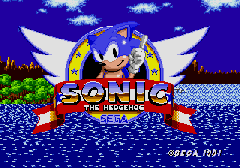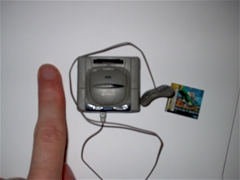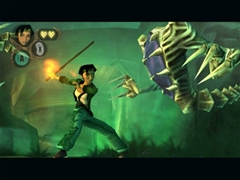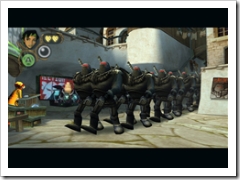As regular readers and fans of important video game composers everywhere are aware, today was the day of Richard Jacques’s SEGA: A Retrospective concert in Nottingham’s St Mary’s Church. How was it? I’ll tell you!
SE-GA!
Sitting at the piano a little after two, Mr Jacques began with his specially-arranged version of the medley to the end credits of Sonic the Hedgehog. He played piano whilst his laptop and some very nice kit provided the rest of the orchestration, and it sounded awesome. I would have loved to have heard what he could have done with more Sonic music, but perhaps that’s next year!
Second up was Shenmue: Improvisations, another medley of all the main themes from AM2’s Shenmue. During this particular piece I was struck by how identifiable and yet versatile these themes are, as Richard transposed and intertwined them expertly.
Richard Jacques: Defender of the Future (of video game music)
After these two undeniably “big” tracks we had two perhaps lesser-known tunes: the main theme from Ecco: Defender of the Future and a very playful rendition of Diamond Dust zone from Sonic 3D: Flickies Island on the Saturn. The latter was the first Richard Jacques soundtrack I ever heard, and I learnt today he composed, recorded and mixed it all in just two weeks, which is frankly incredible considering its quality and the number of strong themes and melodies it possesses.
Following this Richard had a special guest join him on stage, long-time collaborator and voice of many Jacques tracks (this doesn’t work now I know how his name is really pronounced, but never mind), T.J. Davis! I was glad she made the concert as I don’t think any other singer would be able to do the tracks justice, but she proved she’s as good live as on record with two great versions of Sonic R’s all-time classic “Can You Feel the Sunshine?” and Metropolis Street Racer’s most poppy tune, “I Can Still Believe”. Neither of these are easy tracks to sing with lots of high parts, modulations and so on, but they did a great job between them and seemed to enjoy revisiting tracks that they recorded almost five or ten years ago! The arrangements for these tracks were also great, with a lovely crisp acoustic guitar in the background and a little gentle percussion; perfect.
A one-man Anti Music-Crime Network
Okay, so the references are a little laboured, but Richard’s performance is going from strength to strength. Of all the impressive themes from his rightly celebrated Headhunter soundtracks, he chose to perform the gentle yet evocative “Jack’s Dream”, wisely avoiding the bombast of Jack’s Theme for a more atmospheric track that sounded great again. All the main Headhunter themes were there, and again I was struck by how clearly he creates and states his themes, yet how versatile they are too. People sometimes assume classical music and video game music are closer than people would like to admit, but I find video game music tends to be more overtly emblematic and thematic than classical music; in that regard it certainly has more in common with film scoring. Anyway, that’s neither here nor there.
Had I not snuck a look at the next track in the – very nice – programme, I would have been very shocked and possibly even taken to hospital. The brushes, the piano, the drums… it’s Dreams Dreams! I was sincerely hoping T.J. would join him for this one, but it was an instrumental rendition instead; a little disappointing, but Richard did a great job of capturing the nuances and flavour of the original vocals. As with Sonic, I would have loved to have heard more NiGHTs music – as complex as it is, I’m sure Richard would have done an awesome job. I hereby make an extremely request for more NiGHTS music at GameCity 2007!
Last Wave
Had it been that kind of concert I would have been up and dancing like a madman to the next two tunes, a seamless medley between Richard’s Euro remixes of Magical Sound Shower and Passing Breeze. The tunes themselves are a joy to listen to in any form, but the Euro remixes are exemplary, with wonderful Latin percussion, bold brassy colours and
huge amounts of sheer fun and joy. Seeing and hearing them played live was a similar joy, and demonstrated Mr Jacques’s amazing piano skills, both tracks involving very fast modulations and fingerwork. Perhaps the best part was the awesome jazzy breakdown between the two tracks that absolutely stunned me. Tremendous.
Crikey
I haven’t even got to the best part yet. Before leaving the church I spotted T.J. Davis at the front signing an autograph for a young gentleman (who lent us his pen; much obliged!), and so Phil and I both strode forward and received lovely personalised autographs on our very nice programmes. Thanks, T.J.!
The piece de (UK) resistance
A little way away from the venue, Lee Rosie’s Tea Rooms hosted Sonic’s birthday party. The birthday boy himself attended – and gave me a hug, cheers Sonic! – as did Mr Jacques at 4pm. He was quite happy to sit and chat to anyone who came up to him, not getting near his coffee for a good half hour or so! Of course, about twenty of those minutes were taken up by Phil and I as we – mostly Phil, actually – engaged Mr Jacques in topics such as prepared pianos, who had the best Sonic shirt and how often people mispronounce his name. For years I assumed it was “Jaxx”, but recently found – thanks to UK:Resistance – that it is in fact “Jakes”. Many blushes spared there.
I can’t remember the entire conversation we had, but I do know that he was a very interesting and friendly man who seemed interested in what we had to say, gave his thoughts on various matters – we discussed how I might achieve a moody Max Payne sound for my soundtrack – and shook our hands and said perhaps we’ll catch up at GameCity next year.
Thank you
Well, with a day such as today it’s only right I make a long, detailed post. The concert itself was wonderfully arranged and performed and I would have been very happy just with that, but actually getting to talk to someone whose music I have listened to and been inspired by for years was an honour, especially as he was a really nice bloke.
Mr Jacques, thank you for the concert and taking the time to meet and talk to us. Also, if you don’t want that “spare” t-shirt, I’m sure I could find a home for it!
LINKS:
Richard Jacques’s homepage
GameCity
UK:Resistance – fuelled with Jacques love.


 Canny TCW subscribers will have noticed I didn’t update my Virtual Tour yesterday. Having cycled over 300km in just over a week I thought I deserved a break, so only did half my distance yesterday. I should be back to full speed today or tomorrow, so don’t think I’ve given up!
Canny TCW subscribers will have noticed I didn’t update my Virtual Tour yesterday. Having cycled over 300km in just over a week I thought I deserved a break, so only did half my distance yesterday. I should be back to full speed today or tomorrow, so don’t think I’ve given up!

 Animal Crossing:
Animal Crossing: Beyond Good and Evil
Beyond Good and Evil
 All this helps Beyond Good and Evil to achieve the focus it needs. Although its story deals with an entire planet under threat, it has the emotional clarity due to its total devotion to this one character. It reminds me of what was wrong with The Day After Tomorrow, where the viewer was so often separated from its main character that the film’s core was misplaced. Here, Ubisoft maintain this tight grip on Jade, making her the game’s driving force.
All this helps Beyond Good and Evil to achieve the focus it needs. Although its story deals with an entire planet under threat, it has the emotional clarity due to its total devotion to this one character. It reminds me of what was wrong with The Day After Tomorrow, where the viewer was so often separated from its main character that the film’s core was misplaced. Here, Ubisoft maintain this tight grip on Jade, making her the game’s driving force. The media I listed earlier are used to present this strange world to the player in much the same way as our own. We watch news bulletins, films, read emails and so on about our own world, so why not Hyllis? Rather than create a bizarre and arbitrary way of communication, Ubisoft use the best mankind has collectively designed in its history. Pretty smart, and much cheaper too, I’m sure.
The media I listed earlier are used to present this strange world to the player in much the same way as our own. We watch news bulletins, films, read emails and so on about our own world, so why not Hyllis? Rather than create a bizarre and arbitrary way of communication, Ubisoft use the best mankind has collectively designed in its history. Pretty smart, and much cheaper too, I’m sure.
 Taking photos of the many animals on Hyllis provides you with both forms of the game’s currency, namely credits and pearls. Credits buy you little things (and sometimes pearls), and the pearls buy you upgrades at Mammago garage, they of the talking Jamaican rhinos.
Taking photos of the many animals on Hyllis provides you with both forms of the game’s currency, namely credits and pearls. Credits buy you little things (and sometimes pearls), and the pearls buy you upgrades at Mammago garage, they of the talking Jamaican rhinos. My name is James Newton, and this is my website - a collection of my writings about
videogames, music and all my other thoughts.
My name is James Newton, and this is my website - a collection of my writings about
videogames, music and all my other thoughts.